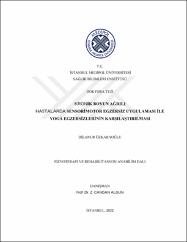| dc.contributor.advisor | Algun, Zeliha Candan | |
| dc.contributor.author | Özkaraoğlu, Dilanur | |
| dc.date.accessioned | 2023-11-01T10:35:49Z | |
| dc.date.available | 2023-11-01T10:35:49Z | |
| dc.date.issued | 2022 | en_US |
| dc.date.submitted | 2022-06-30 | |
| dc.identifier.citation | Özkaraoğlu, D. (2022). Kronik boyun ağrılı hastalarda sensorimotor egzersiz uygulaması ile yoga egzersizlerinin karşılaştırılması. (Yayımlanmamış doktora tezi). İstanbul Medipol Üniversitesi Sağlık Bilimleri Enstitüsü, İstanbul. | en_US |
| dc.identifier.uri | https://tez.yok.gov.tr/UlusalTezMerkezi/tezSorguSonucYeni.jsp | |
| dc.identifier.uri | https://hdl.handle.net/20.500.12511/11684 | |
| dc.description.abstract | Kronik boyun ağrısı, küresel ve oldukça yaygın bir halk sağlığı sorunudur. Literatürde medikal, konvansiyonel ve tamamlayıcı pek çok farklı tedavi mevcuttur. Bu nedenle çalışmamızda, konvansiyonel yöntemlerden biri olan sensorimotor egzersiz uygulaması ile tamamlayıcı yöntemlerden olan yoga egzersizlerinin etkinliğini karşılaştırmak amaçlandı. Dahil edilme kriterlerine uyan 50 kronik boyun ağrılı hasta çalışmaya alındı. Hastalar randomize olarak, sensorimotor egzersiz (SME) grubu ve yoga egzersiz (YE) grubu olmak üzere iki gruba ayrıldı. Hastaların eklem pozisyon hissi Lazer İmleç Yardımlı Açı Tekrarlama Testi (LİYATT), eklem hareket açıklığı (EHA) App G-Pro© (Apple uygulama tabanlı dijital inklinometre), ağrı şiddeti Numerik Ağrı Skalası (NAS), fonksiyonellik Boyun Özürlülük Sorgulama Anketi (BÖSA), kinezyofobi düzeyi Tampa Kinezyofobi Ölçeği (TKÖ), yaşam kalitesi Kısa Form-36 (SF-36) ile çalışmanın başında ve 8 hafta sonunda değerlendirildi. Her iki grupta da tedavi sonrasında; LİYATT fleksiyon ve sağ rotasyon değişimi anlamlıydı (p<0,05). Gruplar arasında, sol lateral fleksiyon hariç diğer tüm yönlerdeki LİYATT değerlerinin ortalamalarındaki değişim SME grubunda daha anlamlıydı. Her iki gruptaki tedavi sonrası EHA değişim anlamlı olmasına karşın; SME grubunda sağ rotasyon hariç tüm EHA değişimi YE grubuna göre anlamlıydı (p<0,05). Her iki grupta da tedavi sonrası NAS ve BÖSA değişimi anlamlıydı (p<0,05). SME grubundaki değişim YE grubuna göre daha fazlaydı (p< 0,001). TKÖ'de her iki grupta da tedavi sonrasında anlamlı bir fark yoktu (p>0,05). Buna karşın kinezyofobi değeri ortalamalarındaki düşüş SME grubunda daha fazla bulundu (p< 0,05). SF-36 alt parametrelerindeki fiziksel ve duygusal nedenli rol sınırlamaları, ağrı/yorgunluk ve duygusal refahtaki iyileşmenin YE grubunda; fiziksel sosyal işlevsellik, ağrı ve genel sağlık parametrelerindeki iyileşmenin SME grubunda daha fazla olduğu belirlendi (p< 0,05). Sonuç olarak SME'nin YE'ye göre daha iyi sonuç verdiği belirlenmiştir. | en_US |
| dc.description.abstract | Chronic neck pain is a global and common public health problem. There are many different medical, conventional and complementary treatments in the literature. Therefore, in our study, it was aimed to compare the effectiveness of sensorimotor exercise, which is one of the conventional methods, and yoga exercises, which is one of the complementary methods. Fifty patients with chronic neck pain who met the inclusion criteria were included in the study. The patients were randomly divided into two groups as the sensorimotor exercise (SME) group and the yoga exercise (YE) group. Before and after 8 weeks of treatments; Joint position sense was evaluated with Laser Pointed Angle Reproduction Test (LP-ART), range of motion (ROM) with App G-Pro© (Apple application-based digital inclinometer), pain intensity with Numerical Pain Scale (NPS), functionality with Neck Disability Index (NDI) , kinesiophobia level with Tampa Kinesiophobia Scale (TKS), quality of life with Short Form-36 (SF-36). After treatment in both groups; LP-ART flexion and right rotation changes were significant (p<0.05). Between the groups, the change in the mean LP-ART values in all directions except left lateral flexion was more significant in the SME group. Although the change in ROM after treatment in both groups was significant; except for the right rotation, all ROM change in the SME group was significant compared to the YE group (p<0.05). NPS and NDI changes were significant in both groups after treatment (p<0.05). The change in the SME group was higher than in the YE group (p< 0.001). There was no significant difference in TKS after treatment in both groups (p>0.05). However, the decrease in the mean kinesiophobia values was higher in the SME group (p< 0.05). It was determined that the improvement SF-36 sub-parameters physical and emotional role limitations, pain/fatigue and emotional well-being was higher in the YE group; but in physical social functionality, pain and general health parameters was higher in the SME group (p< 0.05). As a result, it was determined that SME gave better results than YE. | en_US |
| dc.language.iso | tur | en_US |
| dc.publisher | İstanbul Medipol Üniversitesi, Sağlık Bilimleri Enstitüsü | en_US |
| dc.rights | info:eu-repo/semantics/openAccess | en_US |
| dc.subject | Ağrı | en_US |
| dc.subject | Eklem Pozisyon Hissi | en_US |
| dc.subject | Kronik Boyun Ağrısı | en_US |
| dc.subject | Sensorimotor Egzersiz | en_US |
| dc.subject | Yoga | en_US |
| dc.subject | Chronic Neck Pain | en_US |
| dc.subject | Joint Position Sense | en_US |
| dc.subject | Pain | en_US |
| dc.subject | Sensorimotor Exercise | en_US |
| dc.subject | Yoga | en_US |
| dc.title | Kronik boyun ağrılı hastalarda sensorimotor egzersiz uygulaması ile yoga egzersizlerinin karşılaştırılması | en_US |
| dc.title.alternative | Comparison of sensorimotor and yoga exercise in patients with chronic neck pain | en_US |
| dc.type | doctoralThesis | en_US |
| dc.department | İstanbul Medipol Üniversitesi, Sağlık Bilimleri Enstitüsü, Fizyoterapi ve Rehabilitasyon Ana Bilim Dalı | en_US |
| dc.authorid | 0000-0002-9793-3952 | en_US |
| dc.relation.publicationcategory | Tez | en_US |
| dc.institutionauthor | Özkaraoğlu, Dilanur | |


















